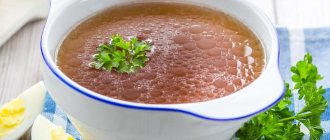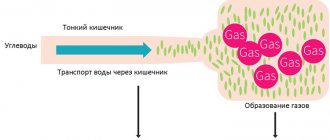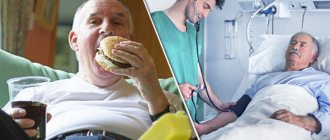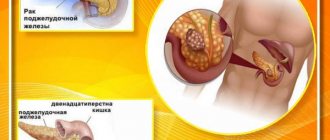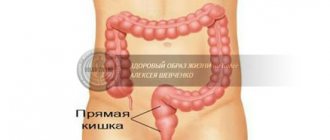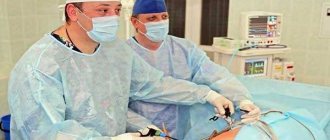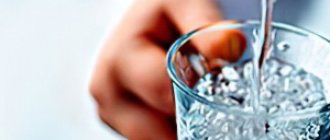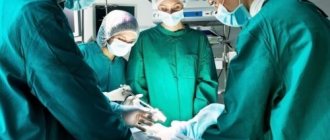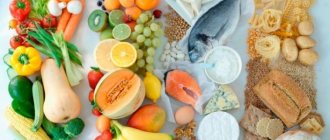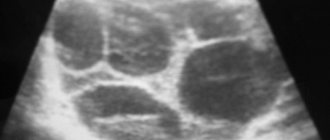General rules
Removal of the uterus ( hysterectomy ) or the uterus and appendages ( hysterosalpingo-oophorectomy ) are the most common operations in gynecology. They are not necessarily used in the presence of malignant tumors. Indications may include trauma and heavy uterine bleeding, endometriosis , multiple or large leiomyomas , ovarian cysts, etc.
In any case, anesthesia and surgery are stress for the body, which causes local and general reactions and must be overcome. After abdominal intervention, the postoperative period is divided into early and late. The early one lasts the first three to four days, the second one lasts up to 12-20 days. On the first day, all patients are recommended to be completely hungry, and fluid losses are replenished with intravenous solutions. In the absence of vomiting, which is associated with irritation of the gastrointestinal mucosa by a narcotic substance, no earlier than 3-4 hours after the operation you can drink strong tea with lemon. And when an appetite appears (after 12-24 hours, depending on the condition), a woman can switch to light food: kefir, yogurt, broth.
Of course, a gentle diet is necessary, excluding aggressive, difficult-to-digest or irritating foods that irritate the gastrointestinal mucosa. This is explained by the fact that during abdominal surgery the peritoneum and intestinal loops are exposed, cooled and injured, no matter how carefully they are handled. General anesthesia also has a negative effect. This is why flatulence , pain and colic in the abdomen occur, which most often disappear by the third day.
Proper nutrition, which gradually expands, helps restore the function of the gastrointestinal tract. On the second day, add liquid porridge (oatmeal, semolina, buckwheat), vegetable puree, crackers, light cereal and vegetable soups, omelet, soft-boiled eggs. That is, it is recommended to eat within Table No. 1B .
It is mandatory to introduce into the diet foods that enhance intestinal motility: soaked prunes, grated beets with vegetable oil, or any foods familiar to a woman that stimulate bowel movements. After the first natural bowel movement, nutrition can be expanded, and meat, fish, and crumbly cereals are recommended. It is allowed to drink an infusion of rose hips and sea buckthorn, dried fruit compote, and jelly are limited if you are prone to constipation .
In general, nutrition after abdominal gynecological surgery is based on the principles:
- Fractionality - I take it up to 7 times a day in not very large portions.
- Inclusion of products to restore natural bowel function, since after strip surgery many experience bowel paresis. The emphasis is on foods containing dietary fiber (vegetables, prunes, fruits), but they should be boiled or stewed, as raw foods cause bloating.
- Avoiding foods that cause bloating. You should not eat bread, cabbage, carbonated water, legumes, yeast baked goods, kvass, raw vegetables and fruits, and whole milk.
- Exclusion of fixing products: strong tea and coffee, chocolate, rice, hard-boiled eggs.
- Gradual introduction of meat and fish dishes, especially if you are prone to constipation, since protein foods provoke them.
- Steaming or boiling dishes.
- Maintain a drinking regimen of 1.5 liters per day or more (as recommended by a doctor).
- Excluded from the diet: fatty and fried foods, confectionery, strong tea, coffee, spicy foods, spices, chocolate.
After discharge from the hospital, a relatively gentle diet should be followed for up to one month. For some women, this period is reduced to two weeks. It is imperative to monitor daily bowel movements to avoid constipation. After the operation, you are not allowed to push - this poses a threat to the sutures. In this regard, products that have a fixing effect and slow down peristalsis are initially excluded. These include pureed soups, boiled slimy porridges, jelly, rice and pureed food, chocolate, cottage cheese in large quantities, an abundance of meat products and protein foods in general, strong tea, cocoa, dough products, pomegranates, quince, blueberries, flour products a lot.
Bloating should also not be allowed, so legumes, kvass, black bread, grapes, raisins, herbs and spices should be excluded. At this stage, a balanced diet is important, since processes are activated: protein synthesis, necessary for growth and development, is enhanced. The functions of the gastrointestinal tract and cardiovascular system are restored.
Nutrition must include proteins, fats, vitamins and carbohydrates. On average, the calorie intake should be 2800-2900 kcal, protein up to 95 g, the same or slightly more fat and 400 g of complex carbohydrates. During the recovery period, it is important to eliminate the deficiency of proteins and vitamins that occurs due to blood loss, fever and breakdown of tissue proteins.
A sufficient amount of protein (meat, cottage cheese, dairy products, eggs, fish) and healthy fats, the sources of which are nuts, fatty fish, and vegetable oils (especially olive, sesame and flaxseed), are introduced into the diet. Restrictions apply only to simple carbohydrates (sweets, sugar, flour products). Complex carbohydrates (cereals, cereal breads, vegetables) are the main source of energy, so they must be included in the diet.
https://youtu.be/AQwLkTeZ9TI
Solid food after anesthesia
Food products such as meat, mushrooms, fish, and a wide variety of vegetables are necessary for every human body to function properly. It is imperative to introduce them into the diet of a patient who has undergone surgery under general anesthesia. This should be done as carefully and individually as possible. Each patient is a special case and needs a competent approach and support from specialists, both before and after surgery.
At the end of the first week after surgery, you can try introducing solid foods into your diet.
Already during the first week after surgery, most patients are recommended to gradually introduce solid food into the diet, the amount of which can initially be limited to 30-50 g per day. Expanding the diet helps normalize the functioning of the gastrointestinal tract. On the psychological side, a patient who can calmly chew, for example, a piece of boiled fish or meat, in the absence of nausea and vomiting, as well as problems with peristalsis, begins to better believe in his recovery.
The main rule for all people who have recently undergone complete anesthesia is to eat small meals frequently. In addition, during the first weeks after anesthesia, it is strictly forbidden to eat fried, spicy, salty, smoked food and canned food. All food and drink must be freshly prepared and warm.
(Ratings: 6 , average: 3.33 )
Authorized Products
The diet after abdominal gynecological surgery includes:
- Dishes made from lean beef, chicken, veal, rabbit, steamed or boiled. Depending on your preference, you can cook the meat in the form of chopped products (cutlets, meatballs, etc.) or in pieces.
- Soups with vegetable or weak meat broths. They add cereals, vermicelli and vegetables.
- Dried wheat bread is limited at first. Dry cookies are introduced.
- Low-fat fish at first, and during the rehabilitation period the diet is expanded by introducing fatty fish 1-2 times a week. Cooking method: steamed, boiled or baked.
- Soft-boiled eggs or omelet.
- Low-fat milk is initially limited or excluded due to possible bloating of the intestines after consumption. Then it is introduced into dishes (milk porridge, milk soups). Sour cream as a seasoning for dishes. Any fermented milk drinks that are well tolerated. Half-fat cottage cheese is limited only if you are prone to constipation.
- Cereals in the form of porridges and casseroles. It is worth considering that corn, pearl barley, millet and barley are difficult to digest, so they are excluded for two weeks after the operation and then carefully introduced.
- At first, vegetables are consumed boiled, baked or stewed, excluding coarse ones (radish, radish, mushrooms). They are used to make puree, caviar, and stew. Subsequently, vegetables are introduced fresh - salads with vegetable oil.
- Fruits and berries are first consumed in heat-treated form - compotes, as an additive when cooking porridge, jelly (in the absence of constipation).
- Drinks: vegetable and fruit juices, rosehip infusion, still water, weak tea (with milk), oat decoction is useful.
Table of permitted products
| Proteins, g | Fats, g | Carbohydrates, g | Calories, kcal | |
Vegetables and greens | ||||
| eggplant | 1,2 | 0,1 | 4,5 | 24 |
| zucchini | 0,6 | 0,3 | 4,6 | 24 |
| cabbage | 1,8 | 0,1 | 4,7 | 27 |
| broccoli | 3,0 | 0,4 | 5,2 | 28 |
| carrot | 1,3 | 0,1 | 6,9 | 32 |
| cucumbers | 0,8 | 0,1 | 2,8 | 15 |
| salad pepper | 1,3 | 0,0 | 5,3 | 27 |
| parsley | 3,7 | 0,4 | 7,6 | 47 |
| iceberg lettuce | 0,9 | 0,1 | 1,8 | 14 |
| tomatoes | 0,6 | 0,2 | 4,2 | 20 |
| pumpkin | 1,3 | 0,3 | 7,7 | 28 |
| dill | 2,5 | 0,5 | 6,3 | 38 |
Fruits | ||||
| bananas | 1,5 | 0,2 | 21,8 | 95 |
| apples | 0,4 | 0,4 | 9,8 | 47 |
Nuts and dried fruits | ||||
| nuts | 15,0 | 40,0 | 20,0 | 500 |
| dried figs | 3,1 | 0,8 | 57,9 | 257 |
| dried apricots | 5,2 | 0,3 | 51,0 | 215 |
| dried apricots | 5,0 | 0,4 | 50,6 | 213 |
| prunes | 2,3 | 0,7 | 57,5 | 231 |
Cereals and porridges | ||||
| buckwheat (kernel) | 12,6 | 3,3 | 62,1 | 313 |
| oat groats | 12,3 | 6,1 | 59,5 | 342 |
| pearl barley | 9,3 | 1,1 | 73,7 | 320 |
Flour and pasta | ||||
| buckwheat noodles | 14,7 | 0,9 | 70,5 | 348 |
Bakery products | ||||
| bran bread | 7,5 | 1,3 | 45,2 | 227 |
| whole grain bread | 10,1 | 2,3 | 57,1 | 295 |
Confectionery | ||||
| jam | 0,3 | 0,2 | 63,0 | 263 |
| fruit and berry marmalade | 0,4 | 0,0 | 76,6 | 293 |
| paste | 0,5 | 0,0 | 80,8 | 310 |
| Maria cookies | 8,7 | 8,8 | 70,9 | 400 |
Raw materials and seasonings | ||||
| honey | 0,8 | 0,0 | 81,5 | 329 |
Dairy | ||||
| kefir 1.5% | 3,3 | 1,5 | 3,6 | 41 |
| Ryazhenka | 2,8 | 4,0 | 4,2 | 67 |
Cheeses and cottage cheese | ||||
| cottage cheese 1% | 16,3 | 1,0 | 1,3 | 79 |
Meat products | ||||
| beef | 18,9 | 19,4 | 0,0 | 187 |
| rabbit | 21,0 | 8,0 | 0,0 | 156 |
Bird | ||||
| boiled chicken breast | 29,8 | 1,8 | 0,5 | 137 |
| boiled chicken drumstick | 27,0 | 5,6 | 0,0 | 158 |
| boiled turkey fillet | 25,0 | 1,0 | — | 130 |
Eggs | ||||
| soft-boiled chicken eggs | 12,8 | 11,6 | 0,8 | 159 |
Fish and seafood | ||||
| flounder | 16,5 | 1,8 | 0,0 | 83 |
| pollock | 15,9 | 0,9 | 0,0 | 72 |
| cod | 17,7 | 0,7 | — | 78 |
| hake | 16,6 | 2,2 | 0,0 | 86 |
Oils and fats | ||||
| butter | 0,5 | 82,5 | 0,8 | 748 |
| olive oil | 0,0 | 99,8 | 0,0 | 898 |
| sunflower oil | 0,0 | 99,9 | 0,0 | 899 |
Non-alcoholic drinks | ||||
| water | 0,0 | 0,0 | 0,0 | — |
| mineral water | 0,0 | 0,0 | 0,0 | — |
| green tea | 0,0 | 0,0 | 0,0 | — |
Juices and compotes | ||||
| apricot juice | 0,9 | 0,1 | 9,0 | 38 |
| carrot juice | 1,1 | 0,1 | 6,4 | 28 |
| peach juice | 0,9 | 0,1 | 9,5 | 40 |
| plum juice | 0,8 | 0,0 | 9,6 | 39 |
| tomato juice | 1,1 | 0,2 | 3,8 | 21 |
| pumpkin juice | 0,0 | 0,0 | 9,0 | 38 |
| rose hip juice | 0,1 | 0,0 | 17,6 | 70 |
| * data is per 100 g of product | ||||
What foods should you avoid?
For rapid rehabilitation after abdominal surgery, foods that can cause flatulence are first excluded from the diet.
In the first time after surgery, you should exclude:
| whole milk | sweet | Carbonated drinks |
The first days after surgery are especially important. At this time, they try to make the diet as gentle as possible. Nutrition during this period should be structured so that the body receives the largest amount of essential nutrients that are easily and quickly absorbed.
Gradually, nutrition after surgery becomes less and less sparing. The patient is transferred from liquid and pureed food to normal food. This will make it possible to reduce the stress caused to the body by surgery and allow it to quickly return to normal.
We should also not forget that most patients after such operations are not able to move independently in the first days. Since the body's powers need to be activated for repair and healing, food must be both nutritious and easily digestible. The body's main strength and energy should be spent on restoration processes, and not on digesting heavy food.
In the first days after surgery, it is especially important to adhere to one of the basic nutritional rules:
- You need to eat little and often. Large amounts of food can make the digestive tract difficult to function.
- It is advisable that the volume of one meal does not exceed 200 grams.
The attending physician should give instructions regarding the volume of fluid required by the patient during the postoperative period. At the same time, it is strictly not recommended to increase the volume of liquid on your own, as this can cause tissue swelling.
Water can be drunk as soon as the patient comes out of anesthesia, but again, in a volume not exceeding that allowed by the doctor.
Fully or partially limited products
- Fatty meats, smoked meats, goose and duck meat, dried fish, sausages, canned meat and fish.
- Fresh bread, pastries (puff pastry, yeast).
- Raw vegetables and fruits in the first two weeks after surgery.
- Legumes, white cabbage and vegetables with coarse fiber (radish, turnip, radish).
- Animal fats are limited.
- Pepper, ketchup, horseradish, mustard, mayonnaise.
- Sweets.
- Products with artificial additives.
- Black coffee, chocolate, strong tea.
Table of prohibited products
| Proteins, g | Fats, g | Carbohydrates, g | Calories, kcal | |
Vegetables and greens | ||||
| canned vegetables | 1,5 | 0,2 | 5,5 | 30 |
| swede | 1,2 | 0,1 | 7,7 | 37 |
| peas | 6,0 | 0,0 | 9,0 | 60 |
| bulb onions | 1,4 | 0,0 | 10,4 | 41 |
| chickpeas | 19,0 | 6,0 | 61,0 | 364 |
| radish | 1,2 | 0,1 | 3,4 | 19 |
| white radish | 1,4 | 0,0 | 4,1 | 21 |
| beans | 7,8 | 0,5 | 21,5 | 123 |
| horseradish | 3,2 | 0,4 | 10,5 | 56 |
| spinach | 2,9 | 0,3 | 2,0 | 22 |
| sorrel | 1,5 | 0,3 | 2,9 | 19 |
Berries | ||||
| grape | 0,6 | 0,2 | 16,8 | 65 |
Mushrooms | ||||
| mushrooms | 3,5 | 2,0 | 2,5 | 30 |
| marinated mushrooms | 2,2 | 0,4 | 0,0 | 20 |
Nuts and dried fruits | ||||
| raisin | 2,9 | 0,6 | 66,0 | 264 |
Snacks | ||||
| potato chips | 5,5 | 30,0 | 53,0 | 520 |
Cereals and porridges | ||||
| rice | 6,7 | 0,7 | 78,9 | 344 |
Flour and pasta | ||||
| pasta | 10,4 | 1,1 | 69,7 | 337 |
| noodles | 12,0 | 3,7 | 60,1 | 322 |
| vareniki | 7,6 | 2,3 | 18,7 | 155 |
| dumplings | 11,9 | 12,4 | 29,0 | 275 |
Bakery products | ||||
| buns | 7,9 | 9,4 | 55,5 | 339 |
| Rye bread | 6,6 | 1,2 | 34,2 | 165 |
Confectionery | ||||
| pastry cream | 0,2 | 26,0 | 16,5 | 300 |
| shortbread dough | 6,5 | 21,6 | 49,9 | 403 |
Ice cream | ||||
| ice cream | 3,7 | 6,9 | 22,1 | 189 |
Chocolate | ||||
| chocolate | 5,4 | 35,3 | 56,5 | 544 |
Raw materials and seasonings | ||||
| mustard | 5,7 | 6,4 | 22,0 | 162 |
| mayonnaise | 2,4 | 67,0 | 3,9 | 627 |
Dairy | ||||
| milk 4.5% | 3,1 | 4,5 | 4,7 | 72 |
| cream 35% (fat) | 2,5 | 35,0 | 3,0 | 337 |
| whipped cream | 3,2 | 22,2 | 12,5 | 257 |
Meat products | ||||
| fatty pork | 11,4 | 49,3 | 0,0 | 489 |
| salo | 2,4 | 89,0 | 0,0 | 797 |
| bacon | 23,0 | 45,0 | 0,0 | 500 |
Sausages | ||||
| smoked sausage | 9,9 | 63,2 | 0,3 | 608 |
Bird | ||||
| smoked chicken | 27,5 | 8,2 | 0,0 | 184 |
| duck | 16,5 | 61,2 | 0,0 | 346 |
| smoked duck | 19,0 | 28,4 | 0,0 | 337 |
| goose | 16,1 | 33,3 | 0,0 | 364 |
Fish and seafood | ||||
| smoked fish | 26,8 | 9,9 | 0,0 | 196 |
| black caviar | 28,0 | 9,7 | 0,0 | 203 |
| salmon caviar granular | 32,0 | 15,0 | 0,0 | 263 |
| salmon | 19,8 | 6,3 | 0,0 | 142 |
| canned fish | 17,5 | 2,0 | 0,0 | 88 |
| salmon | 21,6 | 6,0 | — | 140 |
| trout | 19,2 | 2,1 | — | 97 |
Oils and fats | ||||
| animal fat | 0,0 | 99,7 | 0,0 | 897 |
| cooking fat | 0,0 | 99,7 | 0,0 | 897 |
Alcoholic drinks | ||||
| dry red wine | 0,2 | 0,0 | 0,3 | 68 |
| vodka | 0,0 | 0,0 | 0,1 | 235 |
| beer | 0,3 | 0,0 | 4,6 | 42 |
Non-alcoholic drinks | ||||
| soda water | 0,0 | 0,0 | 0,0 | — |
| cola | 0,0 | 0,0 | 10,4 | 42 |
| instant coffee dry | 15,0 | 3,5 | 0,0 | 94 |
| sprite | 0,1 | 0,0 | 7,0 | 29 |
| * data is per 100 g of product | ||||
Nutrition menu after surgery (Power mode)
You should be relatively strict with your diet for the first two weeks. In the future, it will be organized on the principles of healthy nutrition. Breakfast can consist of porridge cooked in water or milk. It would be appropriate to add fruit, a little dried fruit or honey to milk porridges. It is better to temporarily exclude ready-made breakfasts and corn flakes due to the sugar content, flavorings and flavor enhancers. Drinks in the morning include tea or coffee with milk, or freshly squeezed juice.
Second breakfast - baked or fresh fruits, cottage cheese with nuts and dried fruits. For lunch, vegetable soup, a meat or fish dish with a side dish of your choice (porridge or vegetables). For an afternoon snack - fermented milk products or fruits. The basis of dinner is a protein dish (meat, fish, chicken, legumes) and stewed vegetables. If you have a problem with increased weight, porridge for dinner is not recommended.
| Breakfast |
|
| Lunch |
|
| Dinner |
|
| Afternoon snack |
|
| Dinner |
|
| For the night |
|
| Breakfast |
|
| Lunch |
|
| Dinner |
|
| Afternoon snack |
|
| Dinner |
|
| For the night |
|
| Breakfast |
|
| Lunch |
|
| Dinner |
|
| Afternoon snack |
|
| Dinner |
|
| For the night |
|
Reviews and results
After strip surgery, the recovery period can last 2-3 months. Some women, mostly young and of childbearing age, note quite a long psychological rehabilitation. This is understandable, since these women cannot become mothers, and some do not even manage to start a family.
- “... I was raised after gynecological surgery on the 2nd day. I slowly crawled to the toilet and urinated without a catheter (before that it had been there for a day). I felt dizzy, weak, and everything inside hurt, but I tried to walk around the room. On the third day I went out into the corridor and the dining room, on the 6th I was at home. There I was on a diet for up to a month: low-fat soups, boiled fish and meat, cottage cheese, kefir, boiled vegetables, baked apples. I limited bread and pastries, sweets. During this month I lost 4 kg. Then, as the doctor recommended, I switched to a common table.”
- “... We performed hysterectomy after childbirth but were unable to stop the bleeding. For the first two days, food was limited and sparing, and then beets, prunes, and pumpkin porridge were brought from home to normalize stool. Upon arriving home, I ate porridge, soups, boiled fish and boiled vegetables. Nothing spicy, fried, less dough to avoid constipation. The first two weeks after surgery are difficult. I recovered physically within a month, but I can’t recover psychologically: insomnia and depression. Psychologically, this is difficult to bear. Sexual desire has disappeared."
- “... I had to agree to the operation, since conservative treatment did not help. The fibroids were growing, my periods were long and so heavy that I was afraid to leave the house. There was also bleeding, the pain was constant, and it was difficult to get up and go to work. I understand that surgery is not healthy, but I had no choice. With all this, I recovered quite quickly, although my hemoglobin was rather low and I was worried about weakness. The diet was restricted for 3 weeks, and then it was expanded within reason. I had to take pills for hemoglobin, and also ate beef and liver every day.”
The role of diet after surgery and its principles
Preparation for surgery to remove the uterus includes taking laxatives, cleansing the intestines, and is, of course, performed on an empty stomach. During the intervention, the intestines are affected, at least to a small extent, because the operation is abdominal. Laparoscopy, or rather, minimally invasive laparoscopic surgery through a probe, is less traumatic in this regard, and this method is increasingly preferred today.
As a result, the digestive organs in any case experience a certain “stress”, and in order to return them to normal functioning, it is necessary to follow a gentle diet. Nutritional therapy is also necessary for other reasons. When the ovaries and fallopian tubes are removed at the same time, the hormonal levels in a woman’s body sharply decrease, and they play a big role in metabolism, in particular fat. Such women quickly gain weight, and here a diet is simply necessary.
In the postoperative period, fractional meals are recommended
Further, the very effect of anesthesia on the body is also not entirely safe; time is needed to stabilize it and restore functions, and diet plays a role. The exception is non-cavitary operations, many of which are performed on an outpatient basis, for example, removal of a cervical cyst with a colposcope through the vagina, excision of erosion, endoscopic blowing of the fallopian tubes, and so on.
In the case of cancer, radiation therapy is often prescribed before or after surgery, and it also has a negative effect on the body; it requires support, including diet.
The basic principles of the diet after hysterectomy are:
- fractional meals up to 6-7 meals per day, reducing its volume by half;
- a gradual increase in the calorie content of food from the “lightest” to the more satisfying;
- increased consumption of drinking water, preferably low-mineralized, without gas - up to 3-4 liters per day, for the fastest removal of toxins after anesthesia, radiation therapy, prevention of blood thickening and thrombosis.
Advice. All this information is necessary for the patient, but in any case, the diet should always be coordinated with the attending physician and follow his recommendations. “Liberty” in nutrition can lead to undesirable consequences.
